Rifles by countries and continents. Mauser from Radom and Mauser Verguero (part 13)
“Knocks,” he said to Kalita.
“Mosinsky, sample thirty-one,” he explained, without analyzing what the captain said.
- Radomsky Mauser did not knock.
- And this sand is not terrible. Though I throw a whole handful into it, shake it out, and it will fire. - Kalita spoke, explaining his words with gestures.
"Four troopers and a dog". Yanush Pshimanovsky
Fewer and fewer remains on the world map of such countries that would not be covered by our cycle “Rifles by countries and continents”. The rifles of such major industrial powers as France and Russia, as well as the USA, such European powers as Sweden and Italy, as well as Switzerland, the “banana republics” of Central America and the Caribbean, and also China and Japan were examined, so that countries , with the rifles that we have not met, there are very few. And the lion's share of everything we viewed. weapons turned out to be rifles of the Mauser brothers system. From this we can conclude that there were better rifles, but, according to the complex of characteristics, this particular rifle turned out to be the most demanded. Moreover, it was both bought and produced locally, which again proves its high manufacturability. Well, today we will see what kind of rifles in the late XIX - early XX century were armed with such states as Poland and Portugal. Such a "scatter" on the map "and there, and here" ...
We will start with Poland, which reappeared only after the First World War on the ruins of the Russian Empire and became a vivid example of the policy of national self-determination. According to one of the provisions of the Versailles Treaty, Poland received the former German arsenal of Danzig with all its production equipment, and she was very lucky in this, one might say. And then, in 1921, also in accordance with the Versailles Treaty of 28 June 1919, German factories of the firm Mauser supplied Poland about 1000 machines in order to pay for military reparations, and the Poles immediately installed them at their weapons factory in Warsaw. The Soviet-Polish war of 1919-1920 played an important role in arming the young Polish state, during which the Poles received a large number of small arms, both delivered to her by her western allies and captured by her as trophies. And here the Polish military could choose which system to take as a basis: the Russian-Soviet "three-line", which in the event of war with Soviet Russia guaranteed the use of a similar patron, the French lebel or the German Mauser. The choice was important because much depended on it. For example, Finland, fighting with the USSR, captured such a large number of captured DP machine guns (near 10000!), Which fully provided them with the need of their troops for this type of weapon (!) And ... refused to manufacture and use their own Lahti-Salorant machine gun M -26!
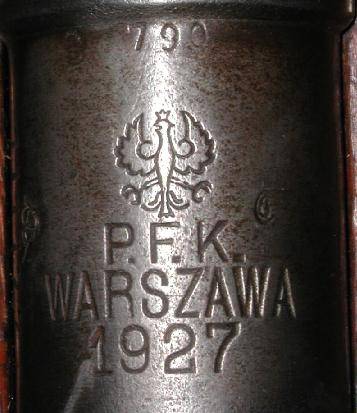
The stamp of the Warsaw Arms Plant.
Ultimately, the German rifle Gew. 98 and Karbiner Kar. 98a were chosen as the main small arms of the new Polish army, and production facilities were organized in Warsaw and Radom. The Poles used both new weapons and reworked those German rifles that remained after the First World War. Polish version of Gew. 98 was designated as Kb Wz. 1898 - "Rifle 1898 model of the year." Polish version of the German Kar. 98a was named KbK Wz. 1898. An additional "K" for a "carbine" meant a short rifle with the bolt handle bent down.
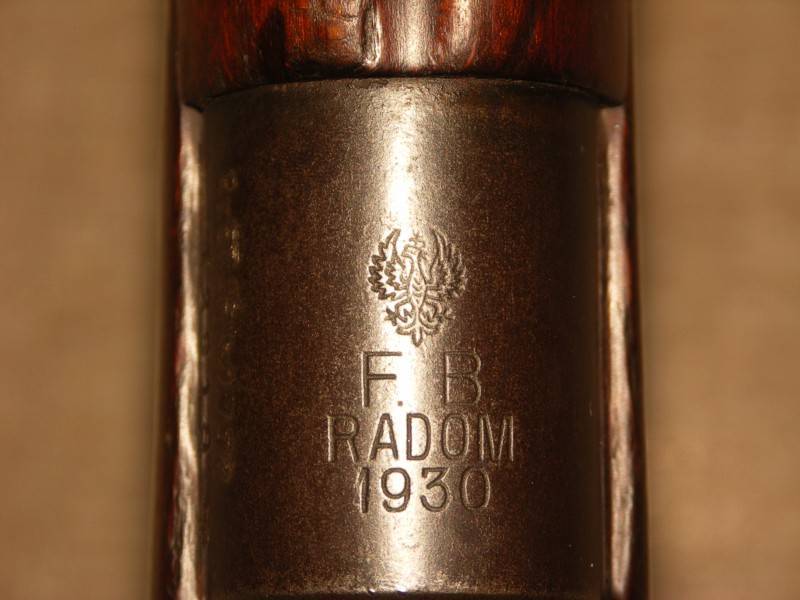
The stamp of the arms factory in Radom.
In 1929, a new short Mauser KbK Wz entered service with the Polish army. 1929, which had a lot in common with the Czech VZ.24. The cavalry version had a folded grip, while the infantry had a straight arm. Oddly enough, in the 1936 year, when almost everyone in the world had already used a short rifle suitable for both infantry and cavalry, the Poles presented a new version of the long Gew. 98, designated as Kb Wz. 1898a. True, she had better workmanship than before, and was intended for shooters specially trained to shoot at long distances.
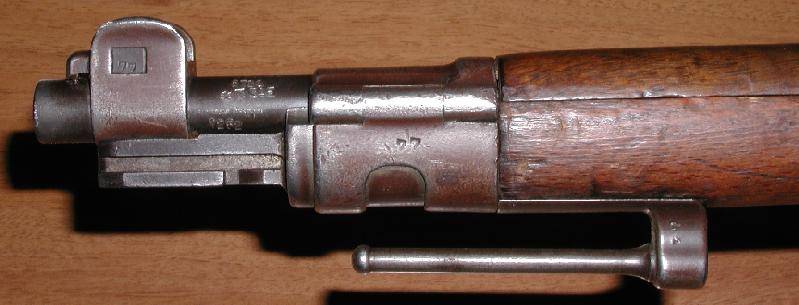
All difference KbK Wz. 1898 from, actually, the German Gew. 98 was in the presence of a hook for putting them into the goats.
Gewer 98 (Army Museum in Stockholm)
In the middle of the 1930-s, the Poles financed their new rifle production, doing what weapons accumulated in the 1919-1920 war sold ... who would you think? Spanish Republicans! This is interesting, since the Polish government did not have the slightest sympathy for them, and the Soviet Union was another major supplier of weapons for the Spanish red! And yet - “the money does not smell!” And so the Polish rifles were in Spain. And not two or three thousand, but a very impressive amount - 95894! In addition, until the beginning of World War II, the Poles retained huge stocks of Russian Mosinov rifles as a strategic reserve.
Polish Mauser rifle Wz.29.
As for the WZ.98a rifle, it was produced by the company Państwowa Fabryka Broni in the 1936-1939. based on the German rifle Gewehr-98 and equipped with a traditional German bayonet. The rifles captured by the Wehrmacht were designated G9-8 (p) or G-299 (p). A total of about 70 thousands of such rifles were produced. TTX carbine: caliber - 7,92 mm; length - 1250 mm; barrel length - 740 mm; weight - 4,4 kg; magazine capacity - 5 cartridges 7,92х57 mm; initial bullet speed - 880 m / s; rate of fire - 15 shots per minute; firing range - 2 km.
After World War II, Soviet weapons in Poland were replaced by the Mausers of the pre-war Polish army, and approximately 373 thousands of Soviet M1944 carbines, which were produced in Poland in the period from 1950 to 1955 a year, received the designation “7,62 mm KbK Wz. 1944.
As for the general stockpiles of weapons in Poland, in December 1921 of the year they were approximately 254 thousand Gewehr-98 rifles and 19 thousand Gewehr-98 carbines a. Approximately 30 thousand of them turned out to be in Poland as a result of the disarmament of units of the German army, another 140 thousand units were bought by the Polish army in Belgium and France, many of which were in turn used trophies. In addition, from the beginning of November 1920 to the end of November 1921, another 84 thousand Mauser rifles and carbines, the data on the origin of which are not available, arrived at the army warehouses.
The mass production of their own weapons at the factory in Warsaw was started already in 1923, and at Radomsky - in 1927. In just one year, the Warsaw factory produced about 22 thousand rifles, and by the 1931 year, 190,5 thousand carbines as well. And the Radomsky plant from 1927 to 1931 is about 158 a thousand year old. 1898 model rifles. In addition, from 1930 to May 1939, the Radom factory manufactured 264300 carbines of the 1929 model of the year, and from 1936 to 1939, the year was also approximately 44500 Kb Wz. 1898a.
At the same time, experts noted that the quality of manufacture of weapons was not too high. Of particular concern was the situation with the carbines, which had numerous shortcomings in terms of reliability and accuracy of shooting. For example, some parts of the shutter could fail after just a few shots, the dispersion when shooting was quite large, and the recoil and muzzle fire - too strong.
Rifle Luis Fausto de Castro Gúdez Díaz.
The first modern rifle in Portugal was adopted in a rather unusual and unexpected way. Initially, the Portuguese military wanted a single-shot rifle. And such a rifle for them was developed by the Portuguese army lieutenant with an impressively long name: Luis Fausto de Castro Gudes Diaz. Goodes’s rifle had a lever-controlled shutter, much like the Martini-Henry rifle. The rifle tests in the 1885 years were successful. The 8x60R welter cartridge showed itself well, but if we look at the year, we will see that this design was late for its time.
Nevertheless, in July 1886, Portugal ordered 40 000 rifles, Goodes of the Year, to the Austrian arms manufacturer OE.WG (Oestterreichische Waffenfabriks-Gesellschaft), better known as the "Steyr". But it was even stranger that Portugal a year earlier had ordered Kropachek 6000 rifles and 3000 carbines with a sliding bolt and a tubular under-barrel magazine, which was almost identical to the M1871 / 84 Mauser model.
Steyr started the order, but met with a number of technological difficulties. Here, Portugal said it was abandoning its order in favor of Kropachek’s rifles. But “Steyr” declared that they had already released 18000 rifles and that in any case they need to pay! And ... Portugal paid for the order, but stated that they do not need it! And then the firm "Steyr" sold them ... to the Boers in South Africa. And it turned out that "Steyr" not only sold the same rifles twice, but also made a profit for non-existent rifles, because at the time of payment Portugal made them all 10000, that is, the Portuguese simply deceived! Thus, those who had passed the tests of the Guns rifle never entered the army of their own country. But there Kropachek rifles got in the following versions: infantry, colonial, "short rifle" and carbine. However, we already talked about this rifle in the pages of IN. True, she did not participate in major military conflicts, unlike the Hudes' rifle, which fought in the Anglo-Boer War (!), But she had the opportunity to shoot in local military conflicts in Angola, Mozambique, East Timor and Goa. Moreover, it is known that their combat career continued in these areas until the 1960s!
Rifle "Manliher-Schönauer" М1903 / 14.
Mannicher-Schönauer rifle M1903 / 14.
Then the Portuguese realized that the weapon with the barrel gantry was outdated; in 1895, they decided to buy a Mannicher rifle and tested it before 1898. But they didn’t like her either, and from 1900 to 1902, they were testing a rifle, which subsequently entered into service with the Greek army - Manlicher-Schönauer under the Greek rifle cartridge 6,5 × 54 mm. But the result was amusing: Greece adopted this rifle in 1903 and used it until the middle of the twentieth century, but Portugal ... decided to adopt the Mauser rifle, but with the bolt from the Mannisher-Schönauer rifle and the 6,5 × 58 cartridge mm Verguero!
Mauser Verguero M1904.
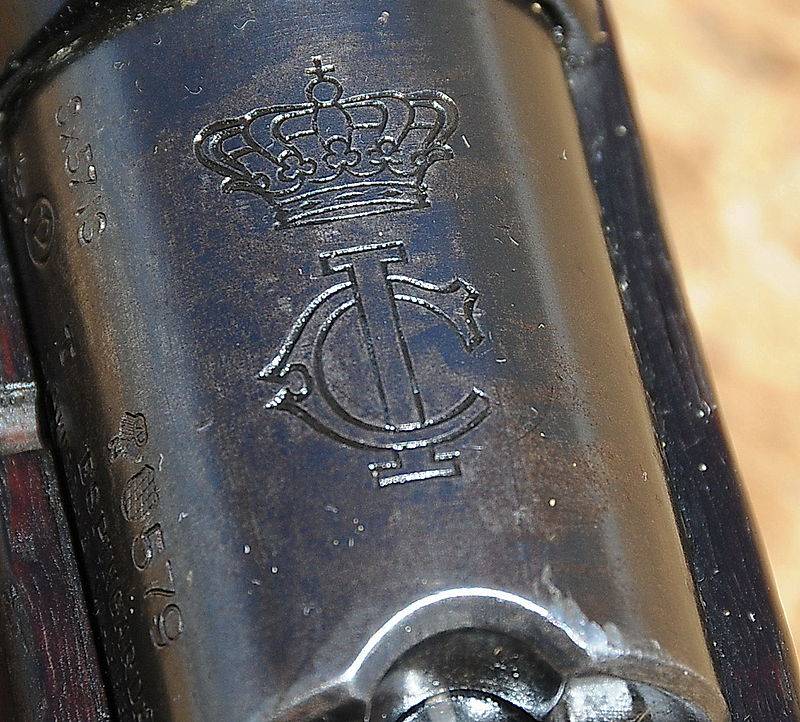
The stamp put on the Mauser-Verguero rifles of the Lisbon arsenal is “Charles I” (King of Portugal с1889 - 1908)
The required work to create a new rifle in 1904 was carried out by an officer of the Portuguese army, José Alberto Verguero, who also developed the cartridge, and his Mauser-Verguero replaced his Kropachek M1886 rifle as a standard infantry rifle of the Portuguese army for the whole time in 1939 his year In turn, they did not replace the 98k Mauser. In Portugal, she wore the official designation Espingarda 6,5 mm m / 1904. A lighter and shorter version of the weapon was classified as a carbine.
Information about the owner and manufacturer of the rifle.
For Portugal, 100 000 rifles were produced. In 1906, additional 5000 Mauser Verguero rifles were manufactured for the Brazilian federal police for 7 × 57 mm cartridges popular in South America. In 1915, the Mauser Verguero 25 000 rifles were sold to South Africa because the South Africans lacked Lee Enfield rifles.
Device sight.
Being in the Portuguese and South African service, this rifle was used in the battles of the First World War and in several colonial campaigns. German colonial troops in East Africa also used Mauser-Verguero rifles captured as trophies. But the Portuguese expeditionary force on the Western Front used British weapons and equipment for logistical reasons, and therefore this rifle was not used by them. Although Portugal was neutral in World War II, in 1942, Portuguese troops briefly fought against the Japanese, who occupied Portuguese Timor, and also used Mauser Verguero rifles.
Shutter and fuse.
In the 1937 year, after the Portuguese army adopted the 7,92 × 57 mm 98k Mauser, many of the remaining rifles of this type were converted to the new 7.92X57 mm. The modified rifles were called Espingarda 8 mm m / 1904-39 and were used in the Portuguese army until the middle of the 1960-ies, mainly in its overseas possessions.
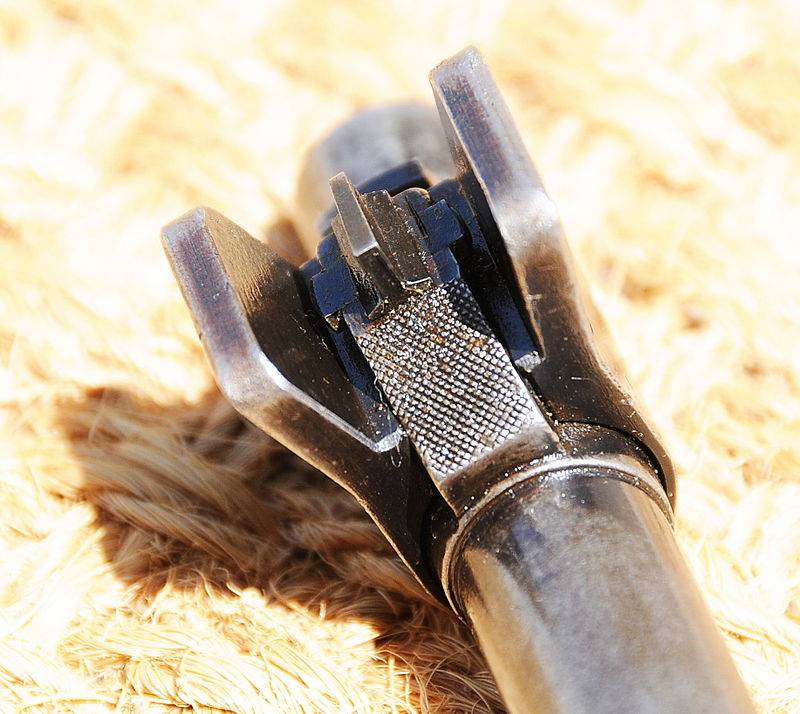
The characteristic design of the front sight with "ears".
The M1937-A carbines, and then the M1941 carbines were produced in Germany at the plant in Oberdorf and carried the German markings on themselves. The Portuguese ordered the Carabiners of the first model and received 60000, but the order for the second model for another 50000 unit for obvious reasons broke down and the already produced weapon arrived in Wehrmacht with the coat of arms of Portugal and the year “1937”, and then “1941” .
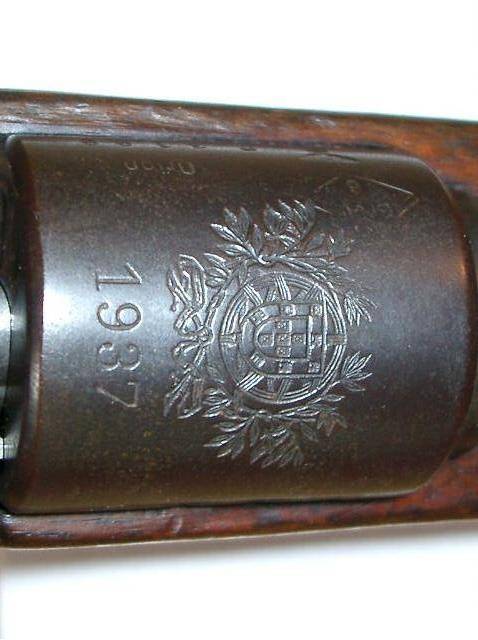
Stamp on 1937 rifles
To be continued ...
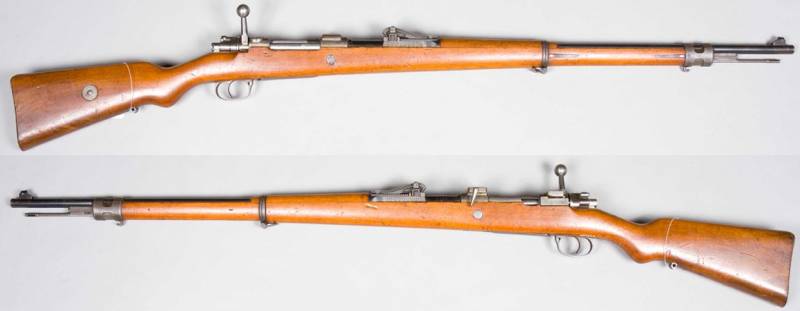

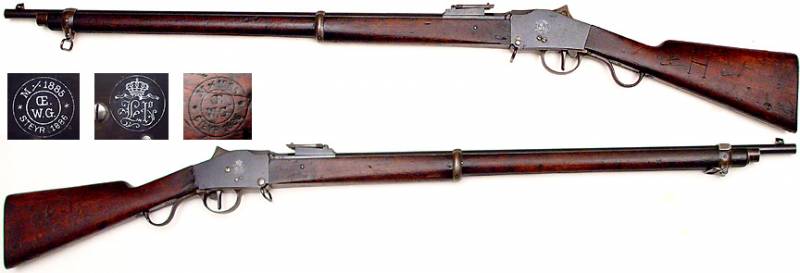

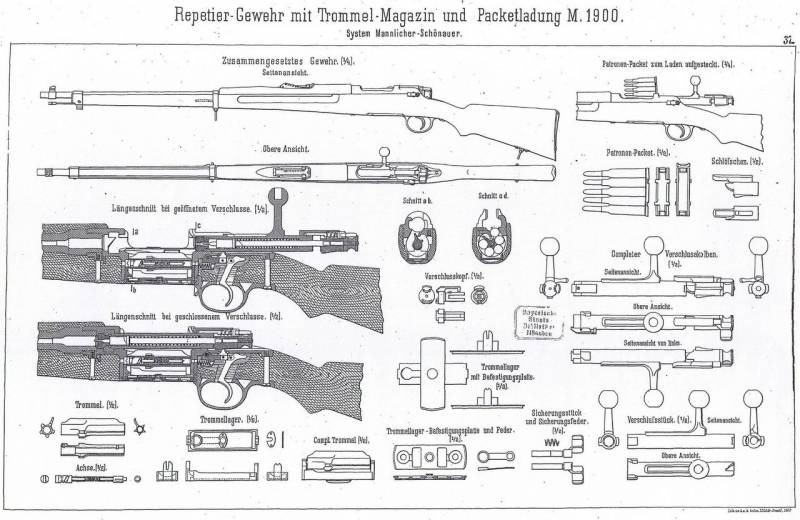

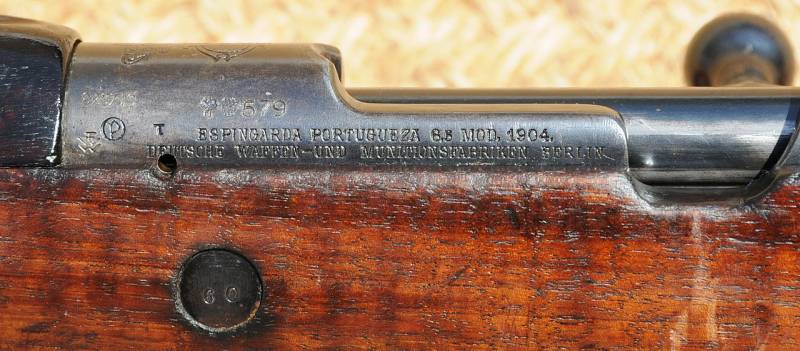
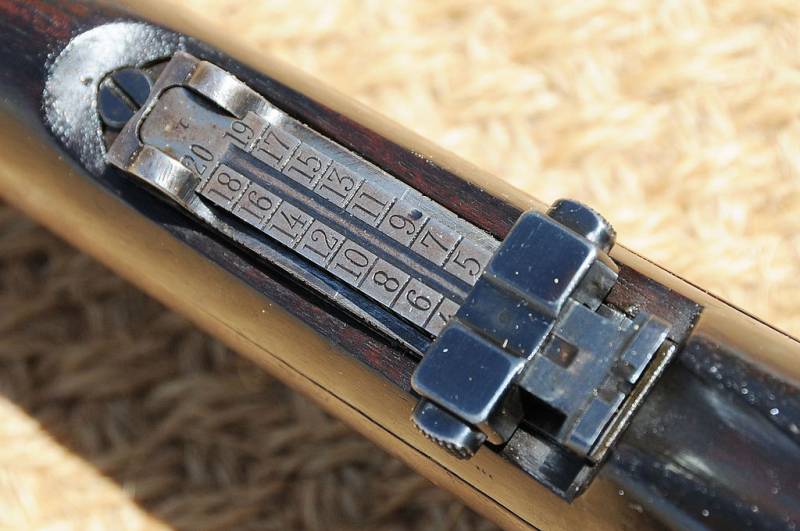
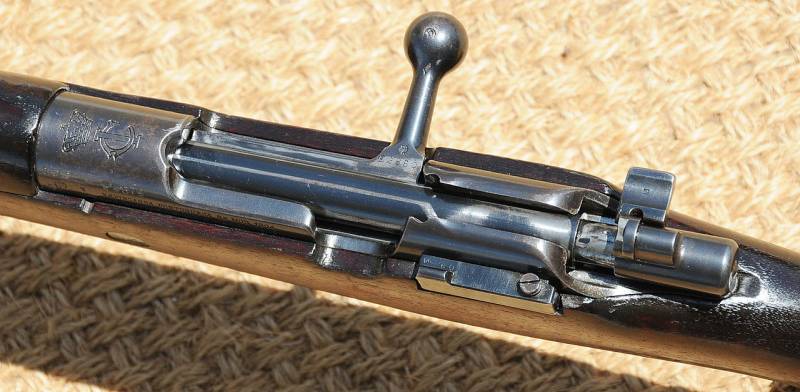
Information